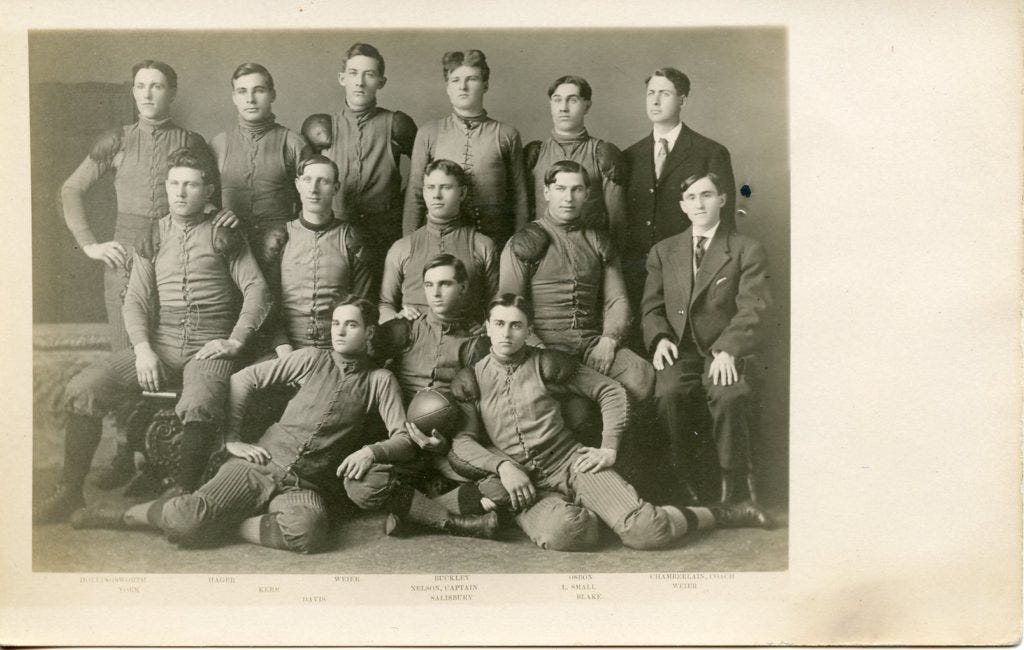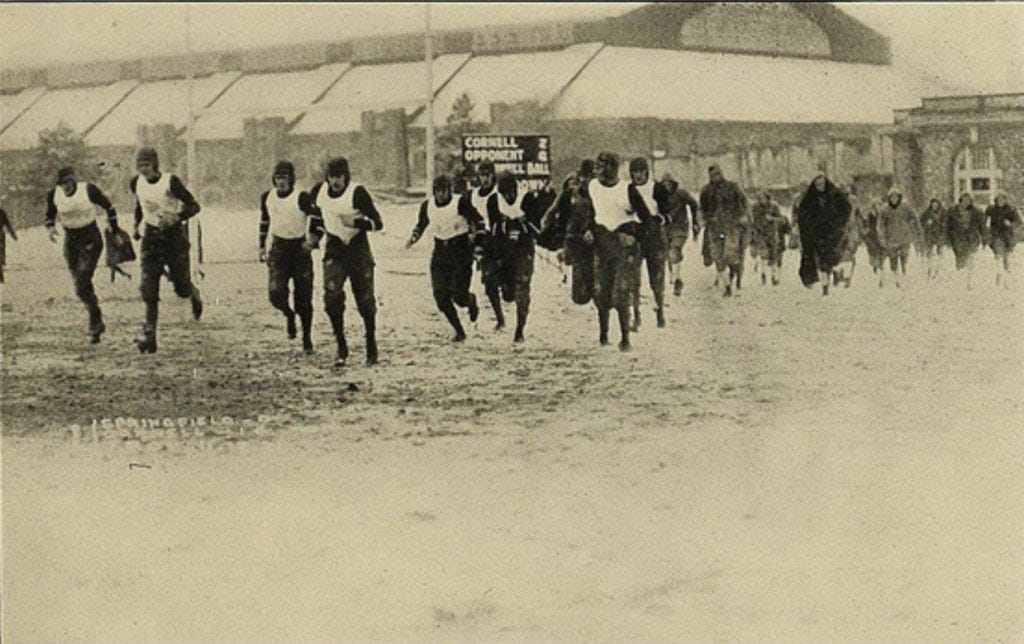The Origins of Home and Away Jerseys: Cornell's Vested Interest
Like other sports, one of football's early challenges was getting competing to teams wear sufficiently distinct uniforms that players, officials, and fans could tell one from the other. During football's rugby days, teams often wore stocking caps and socks of different colors and striping. Colored sweaters continued distinguishing one team from another even when most players wore canvas vests over their sweaters from 1877 until the mid-1910s.

As detailed in How Football Became Football, most teams continued wearing dark jerseys and earth-tone pants into the 1940s. Few teams consistently wore white, gray, or other light colors. The situation was problematic in conferences with multiple teams with similar colors, particularly given the more muted dyes of the day. For example, the Big Nine, now Big Ten, had five teams wear one shade of red or another: Ohio State (scarlet), Indiana (crimson), Chicago (maroon), Wisconsin (cardinal), and Minnesota (maroon). Beginning in the 1910s, some teams distinguished themselves by painting their leather helmets, but football did not have a consistent system to ensure opposing teams wore uniforms of contrasting colors.
Newspaper columnists and reporters frequently complained about teams wearing similar colors, especially when covering games played on muddy fields. The reporters complained when the black jerseys worn by Army bore little difference from the Middies' Navy blue jerseys in 1916 and 1919. Some schools meeting a similarly-hued team took the initiative by borrowing jerseys from a third team. Throop Institute, the future Cal Tech, did just that before their 1919 game with Redlands. When Nebraska visited Rutgers in 1920, the Scarlet Knights wore black jerseys, leading to many Rutgers faithful cheering for the redshirted Cornhuskers in the game's early moments. Rockne dressed his boys in green when they visited the black-shirted Iowa Hawkeyes in 1921.
Multiple articles in the early 1920s discussed the emerging consensus that the home team should ensure their jerseys differed from the visiting team, the opposite of the tradition that ultimately took hold. The image at the top of the post shows Cornell hosting Colgate in 1920 when the wide white band running across the torso of Cornell's jerseys helped differentiate the two teams.
After publishing How Football Became Football, I found a few images showing a unique solution used by Cornell, when the Cornell Big Red hosted their rival, the Colgate Red Raiders (now the Raiders), that wore maroon. In 1921, Cornell lost their white stripe, and rather than borrow jerseys from another school or purchase a second set of jerseys, Cornell wore white vests similar to the scrimmage or practice vests that became popular in the 1940s.

The image clearly shows Cornell had numbers on the backs of their vests.
Despite extensive searching for earlier or other instances of teams wearing vests, the only school found to follow Cornell's lead was Akron, whose teams wore numberless vests in 1924 and 1925. (If you know of others, please comment on this post.) The image below shows Akron's quarterback shortly after taking the snap and before attempting a pass against Ashland in 1924. Akron wore white vests in their home game against Ashland and while visiting Mt. Union in 1924. They also wore them at home against Wooster in 1925.
When Pop Warner took over at Stanford a few years later, he had his team regularly wear white jerseys. Other schools followed later in the 1920s. Similarly, Michigan wore canary yellow jerseys when they hosted the Midshipmen in 1928. Still, consistently wearing jerseys of contrasting colors did not occur until the NCAA required the practice in 1949. Perhaps the rule was spurred on by the absurdity of the 1949 Rose Bowl when the Northwestern Wildcats won the coin toss over California, forcing the Bears to wear white jerseys rather than their standard blue.
By that point, the All-American Football Conference, an NFL competitor, entered its third and final year of play. After dissolving, the Cleveland Browns and San Francisco 49ers joined the NFL, becoming the AAFC's primary legacies. The league's third legacy was the rule requiring the visiting team to wear white jerseys or, at least, light-colored jerseys.
The NFL did not immediately add the "visitor wears white jersey" rule since fans in the stands remained able to distinguish the Packers' green jerseys from the blue of the Bears. Instead, the NFL only required visitors to wear light-colored jerseys in 1957 to lessen the frustration of fans watching games on black-and-white televisions that made two teams wearing dark jerseys virtually indistinguishable. The NCAA, which had required contrasting jersey colors since 1949, did not implement a similar light-versus-dark rule until 1983, long after every school adopted the practice and color televisions made the new rule unnecessary.
Postscript: After publishing this article, I found the following images of Wisconsin using scrimmage vests during practice in 1919, Santa Clara wearing them in a game against Cornell in 1920, and Washington U doing the same versus Oklahoma in 1921. Each school uses a shade of red as its primary color.
Football Archaeology is reader-supported. Click here to buy one of my books or otherwise support the site.





